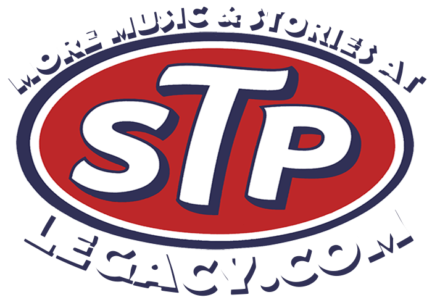Tiny Music… Songs from the Vatican Gift Shop is the third studio album by American rock band Stone Temple Pilots, released on March 26, 1996, on Atlantic Records. After a brief hiatus in 1995, the band regrouped to record Tiny Music, living and recording the album together on a ranch located in Santa Ynez, California.
Tiny Music… saw Stone Temple Pilots moving away from the grunge sound present on their first two records and incorporating a wide variety of different influences. After debuting at No. 4 on the Billboard 200 in 1996, Tiny Music initially received mixed reviews, similar to the band’s earlier work, but in the years since, the record has been acclaimed for its radical reinvention of the band’s image. Tiny Music spawned three singles that reached No. 1 on the Mainstream Rock Tracks chart: “Big Bang Baby”, “Lady Picture Show”, and “Trippin’ on a Hole in a Paper Heart”.
In early 1995, shortly after the band was forced to scrap two weeks’ worth of recorded material, lead singer Scott Weiland was arrested for heroin and cocaine possession and sentenced to one year’s probation. In the months following this incident, Weiland formed his own side-band, the Magnificent Bastards, and recorded songs for the Tank Girl soundtrack and for a John Lennon tribute album.
During this time the rest of the band decided to put together their own side project, which would later become the band Talk Show. In the fall of 1995, when Stone Temple Pilots regrouped to record again for Tiny Music, Robert and Dean got together to figure out which songs should be Tiny Music songs and which songs should be Talk Show songs. Dean would later say “Robert and I had about 30 songs, and we sat in the room one night and basically went down the list and marked next to every song: Scott, Scott, Dave, Scott, Dave, Dave, Scott…. It’s really weird, because in all reality it was like ‘Big Bang Baby’ could’ve been on [the] Talk Show record and ‘Everybody Loves My Car’ could’ve been on Tiny Music.”
Weiland’s drug use continued after his sentence, and STP cancelled some of their 1996-1997 tour for Tiny Music so that he could go to rehab.
Tiny Music displays a drastic change in the band’s sound, featuring music strongly influenced by ’60s rock and bands such as The Beatles. Stephen Thomas Erlewine of Allmusic stated in his review of the album that “Tiny Music illustrates that the band aren’t content with resting on their laurels” and “STP have added a new array of sounds that lend depth to their immediately accessible hooks,” naming shoegaze and jangle pop as two examples of genres explored on the album. Erlewine also wrote that the album “showcases the band at their most tuneful and creative.”
Doug McCausland of Alternative Nation said “Tiny Music really gelled the individual band members’ musical tastes together into a new sound: vocalist Weiland’s underground punk and glam sensibilities, guitarist Dean DeLeo’s upbringing in sixties and seventies rock, and bassist Robert DeLeo’s interest in genres like jazz and bossa nova.”
The album cover features a woman in a swimsuit standing in a pool with a crocodile in it and was created to resemble a 70’s-style LP cover. The cover was made by John Eder, based on an idea from Weiland. The cover model was a family friend of art director John Heiden. Said John Eder, “The little altar in the background was a last minute addition he wanted to put in, and it actually existed in his house, where I went to shoot it.”
Rolling Stone favored the album, regarding it as the group’s best effort to date. They expressed surprise, however, at “the clattering, upbeat character of the music” given Weiland’s much-publicized run-ins with drugs and the law. The magazine also featured STP on its cover of issue No. 753 in February 1997. David Browne of Entertainment Weekly, however, was less favorable of the album, writing that “none of it… has a distinct personality.” Band photographer John Eder recounts of the mixed reception, “I remember [Tiny Music] getting totally trashed critically, for example in Entertainment Weekly, with the critic even singling out and making fun of the bands’ physical appearances – like, their actual body types – in the little snapshot fold-out thing that came in the CD.”
Following Weiland’s death, Billy Corgan of The Smashing Pumpkins posited, “It was STP’s 3rd album that had got me hooked, a wizardly mix of glam and post-punk, and I confessed to Scott, as well as the band many times, how wrong I’d been in assessing their native brilliance. And like Bowie can and does, it was Scott’s phrasing that pushed his music into a unique, and hard to pin down, aesthetic sonicsphere. Lastly, I’d like to share a thought which though clumsy, I hope would please Scott In Hominum. And that is if you asked me who I truly believed were the great voices of our generation, I’d say it were he, Layne, and Kurt.”
In 2016, The A.V. Club noted that Tiny Music “was an almost shocking leap forward in creative ambition” and that “[STP] got weirder and better than anyone gives them credit for.” In the United States, the album debuted at number four on the Billboard 200 albums chart on the issue dated April 13, 1996, with 162,500 copies sold. Because of the tour cancellation, Tiny Music did not receive as much exposure as initially intended. The album was certified 2× platinum but was not as commercially successful as STP’s first two albums.

TINY MUSIC VOCALS ISOLATED HERE
Tiny Music … Songs from the Vatican Gift Shop es el tercer álbum de estudio de la banda estadounidense de rock Stone Temple Pilots , lanzado el 26 de marzo de 1996 en Atlantic Records . Después de una breve pausa en 1995, la banda se reagrupó para grabar Tiny Music, viviendo y grabando el álbum juntos en un rancho ubicado en Santa Ynez, California.
Tiny Music … vio a Stone Temple Pilots alejarse del sonido grunge presente en sus dos primeros discos e incorporar una amplia variedad de influencias diferentes. Después de debutar en el No. 4 en el Billboard 200 en 1996, Tiny Music inicialmente recibió críticas mixtas, similares al trabajo anterior de la banda, pero en los años posteriores, el disco ha sido aclamado por su reinvención radical de la imagen de la banda. Tiny Music generó tres singles que alcanzaron el número 1 en la lista de Mainstream Rock Tracks: ” Big Bang Baby “, ” Lady Picture Show ” y ” Trippin ‘on a Hole in a Paper Heart “.
A principios de 1995, poco después de que la banda se viera obligada a desechar material grabado por dos semanas, el cantante Scott Weiland fue arrestado por posesión de heroína y cocaína y sentenciado a un año de libertad condicional. En los meses que siguieron a este incidente, Weiland formó su propia banda lateral, los Magnificent Bastards, y grabó canciones para la banda sonora de Tank Girl y para un álbum tributo a John Lennon.
Durante este tiempo, el resto de la banda decidió armar su propio proyecto paralelo, que luego se convertiría en la banda Talk Show . En el otoño de 1995, cuando Stone Temple Pilots se reagrupó para grabar nuevamente para Tiny Music , Robert y Dean se reunieron para descubrir qué canciones deberían ser canciones de Tiny Music y cuáles deberían ser canciones de Talk Show . Más tarde, Dean diría “Robert y yo teníamos unas 30 canciones, y nos sentamos en la habitación una noche y básicamente bajamos la lista y marcamos al lado de cada canción: Scott, Scott, Dave, Scott, Dave, Dave, Scott … Es realmente extraño, porque en realidad era como si ‘ Big Bang Baby ‘ pudiera haber estado en [el] registro de Talk Show y ‘Everybody Loves My Car’ podría haber estado enTiny Music “.
El consumo de drogas de Weiland continuó después de su sentencia, y STP canceló parte de su gira de 1996-1997 por Tiny Music para poder ir a rehabilitación.
Tiny Music muestra un cambio drástico en el sonido de la banda, con música fuertemente influenciada por el rock de los 60 y bandas como The Beatles . Stephen Thomas Erlewine de Allmusic declaró en su reseña del álbum que ” Tiny Music ilustra que la banda no se contenta con descansar en sus laureles” y “STP ha agregado una nueva gama de sonidos que le dan profundidad a sus ganchos accesibles de inmediato”. nombrando shoegaze y jangle pop como dos ejemplos de géneros explorados en el álbum. Erlewine también escribió que el álbum “muestra a la banda en su forma más melodiosa y creativa”.
Doug McCausland, de Alternative Nation, dijo que ” Tiny Music realmente combinó los gustos musicales de los miembros de la banda en un nuevo sonido: las sensibilidades de punk y glam underground del vocalista Weiland, la educación del guitarrista Dean DeLeo en los años sesenta y setenta rock, y el interés del bajista Robert DeLeo en géneros como jazz y bossa nova “.
La portada del álbum presenta a una mujer en traje de baño de pie en una piscina con un cocodrilo y fue creada para parecerse a una portada de LP de los años 70. La portada fue hecha por John Eder, basada en una idea de Weiland. La modelo de portada era una amiga de la familia del director de arte John Heiden. John Eder dijo: “El pequeño altar en el fondo era una adición de último minuto que quería poner, y en realidad existía en su casa, donde fui a dispararle”.
Rolling Stone favoreció el álbum, considerándolo como el mejor esfuerzo del grupo hasta la fecha. Sin embargo, expresaron sorpresa por “el carácter estruendoso y optimista de la música” debido a los muy publicitados enfrentamientos de Weiland con las drogas y la ley. La revista también presentó a STP en su portada del número 753 en febrero de 1997. David Browne de Entertainment Weekly , sin embargo, fue menos favorable del álbum, escribiendo que “nada de eso … tiene una personalidad distinta”. El fotógrafo de la banda, John Eder, relata la recepción mixta: “Recuerdo que [Tiny Music] fue totalmente criticado, por ejemplo en Entertainment Weekly, con el crítico incluso señalando y burlándose de las apariencias físicas de las bandas, como sus tipos de cuerpo reales. – en la pequeña imagen desplegable que vino en el CD “.
Después de la muerte de Weiland, Billy Corgan de The Smashing Pumpkins postuló: “Fue el tercer álbum de STP que me enganchó, una mezcla mágica de glam y post-punk, y le confesé a Scott, así como a la banda muchas veces, qué equivocado Estuve evaluando su brillantez nativa. Y como Bowie puede y lo hace, fue la frase de Scott lo que empujó su música a una sonicidad estética única y difícil de precisar. Por último, me gustaría compartir un pensamiento que, aunque torpe, espero complacer a Scott In Hominum. Y si me preguntaran quién creía realmente que eran las grandes voces de nuestra generación, diría que fueron él, Layne y Kurt “.
En 2016, The AV Club señaló que Tiny Music “fue un salto casi impactante en la ambición creativa” y que “[STP] se volvió más extraño y mejor de lo que nadie les da crédito”. En los Estados Unidos, el álbum debutó en el número cuatro en la lista de álbumes Billboard 200 sobre el tema del 13 de abril de 1996, con 162,500 copias vendidas. Debido a la cancelación de la gira, Tiny Music no recibió tanta exposición como se pretendía inicialmente. El álbum fue certificado 2 × platino pero no tuvo tanto éxito comercial como los dos primeros álbumes de STP.
